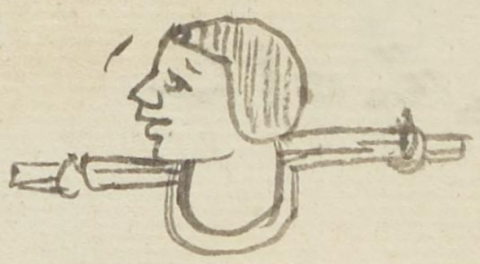Tlaco (MH641r)
This black-line drawing for the simplex glyph of the personal name, Tlaco (seemingly, "Enslaved Person"), shows a man's head in profile, facing toward the viewer's left, and around his neck is a round (likely wooden) collar attached to a horizontal pole or stick (tlacotl). The presence of this restraining collar was how people were marked as enslaved, and it was supposed to inhibit their escape. The word for slave is tlacotli. The absence of anything more than the name "Diego," suggests that he was enslaved, as opposed to being a middle child (tlaco), which is another possible reading for this glyph.
Stephanie Wood
The stick (tlacotl) and the term for slave (tlacotli) can both be reduced to Tlaco, this man's name (or a label for his status as an enslaved person). But one of the words could be seen as a phonetic complement. The gloss suggests Tlacon, but the final "n" is probably intrusive.
John Frederick Schwaller explains (The Church in Colonial Latin America, 2000, 88) how Tiacapan was often the name of the oldest child, Tlaco the name of the middle child, and Xoco the youngest. While Tlaco is more commonly known for girls, Alonso Zamora suggests "Middle Brother" for a reading of this glyph in his blog Tlacuilolli. The stick that is part of the restraint that was put around the neck of an enslaved person can be a tlacotl, the slave a tlacotli, and the half-circle of the throat constrictor could be seen as (tlaco) (half, which is close to the meaning of middle). So, the glyph is at least partly phonographic.
Stephanie Wood
tlacō
Tlaco
Stephanie Wood
1560
Jeff Haskett-Wood
slaves, enslaved persons, slavery, esclavizados, sticks, palos, collares, nombres de hombres

tlaco, middle child (a birth-order name), https://nahuatl.wired-humanities.org/content/tlaco
tlaco(tli), enslaved person, https://nahuatl.wired-humanities.org/content/tlacotli
tlaco(tl), stick, https://nahuatl.wired-humanities.org/content/tlacotl
una persona esclavizada
Stephanie Wood
Matrícula de Huexotzinco, folio 641r, World Digital Library, https://www.loc.gov/resource/gdcwdl.wdl_15282/?sp=364&st=image.
This manuscript is hosted by the Library of Congress and the World Digital Library; used here with the Creative Commons, “Attribution-NonCommercial-ShareAlike 3.0 License” (CC-BY-NC-SAq 3.0).









